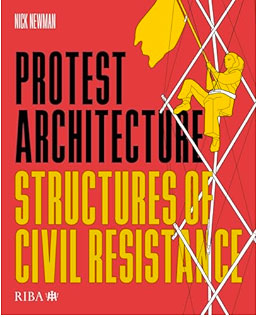

Protest Architecture: Structures of Civil Resistance, Nick Newman (RIBA)
A Bestiary of the Anthropocene, eds. Nicolas Noca and Disnovation.Org (Set Margins)
Two very cool books, both beautifully designed, both unexpected and surprising in content and intent.
Nick Newman’s book is an architectural study of often temporary structures and buildings that have been used within demonstrations and protest encampments over the last few decades. Some have been barricades or blockades, other long term occupational buildings such as treehouses, tunnels or decks, some transient or ephemeral, many built for quick assembly and to enable lock-ons and delays to those trying to remove them.
The book starts by considering how protest architecture might be defined: what it is, what it is for and how it might facilitate change and ideas. It moves on to present a quick survey of how architecture has been part of protests and of protest movements themselves, then briefly presents what it sees as ‘The boundaries of protest architecture’ and precedents such as squatting, protest art, countering ‘hostile architecture’ and anarchist architecture, before moving onto a section where specific forms are considered.
Here, using photos of specific examples along with architectural and structural drawings and descriptions, is where it gets really meaty. The author can’t be unaware that in many ways he is providing a d.i.y. manual for how to construct tripods, towers, tunnels and treehouses! Or simply to inspire lateral thinking about how to make a spectacle, an exhibition or disruption. One of my favourite examples here is Tools for Action’s inflatable barricade, which look like giant silver cobblestones. Newman suggests that
the barricades represent a joyful, non-violent, yet highly disruptive method
of taking up space in a city. When aligned to face a wall of heavily armed
police in riot gear […] the shiny inflatables served to give the protestors the
appearance of the moral high ground, highlighting the absurdity of the state’s
heavy policing response.
The section ends with considerations of new proposals by student architects and of ‘New Forms of [architectural] Practice’, highlighting some of the new networks, associations and groups that have formed in response to protests and new ideas of society, culture, ecology, global warming, overcrowding, preservation, recycling and energy efficiency.
Then it’s on to the third and final section, which adopts a more abstract approach to ‘Protest Design’, with discussions and consideration of protest in relation to planning, health and safety, economics, messaging, logistics and professional & legal considerations. Clearly, some architects are worried about their reputation and their membership and good standing within RIBA (the Royal Institute of British Architects) although Newman notes that architect Tom Bennett, ‘who was arrested for lying down in the street as part of a mass civil disobedience action’ but faced no disciplinary action by RIBA, told him that he (Bennett) hoped this had ‘given other architects some reassurance that it’s possible to undertake civil disobedience on the climate crisis without jeopardising their day jobs.’
The book closes with an uplifting, affirming and positive Afterword, which points out that ‘Perhaps we need an architecture on a more human scale’ and offers a brief summary-cum-manifesto for future response and action: Subvert, Occupy, Unlearn, Prototype, Sacrifice, Celebrate.
A Bestiary of the Anthropocene is not a celebration but a gloriously designed book – silver ink on black paper – intended to ‘capture [the] precise moment when the biosphere and technosphere merge and mesh into one hybrid body’.
This hybridity is key, the adaptation of minerals, plants and fungi in response to the world in the 21st century, usually because of the waste and mess humans have left or the damage we have done. There are, for instance, now hermit crabs who use the likes of a light bulb metal screw as their shell and plastic eating caterpillars, whilst prosthetic limbs for animals and ‘crittercams’ are more positive entries.
Elsewhere there are entries for bacterial superbugs, black mold and coronavirus, cloud seeding and artificial turf, along with a whole section of primitive robots, from Tamagotchis to self-steering hoovers, and then [ab]used animals: coal mine canaries, bomb rats, drone-catching eagles and military dolphins. Homo Sapiens are in the book too, along with the likes of nuclear craters we have produced. It’s an enlightening, sometimes bewildering and often challenging read.
The final section moves away from the bestiary itself to take a look at the notion of classification, consider of artificiality, and notions of landscapes, wilderness and time, as well as the links between geodiversity and biodiversity. The ten articles here are provocative and informative although sometimes at odds with each other. A Bestiary of the Anthropocene is a provocative take on how our world is suffering because of ‘the growth of the human population, industrialisation and massive consumption that gradually led to environmental destruction as well as pollution, significantly contributing to a widespread and rapid decrease of other forms of life’. It’s a welcome, straightforward collection that avoids scaremongering but simply points out what is currently happening in the natural world, often because of us, leaving us to wonder why and perhaps act on our answers.
.
Rupert Loydell
For those interested in discussing the future of protest architecture, exploring new examples or sharing their own creations, please visit protestarchitecture.org
.
